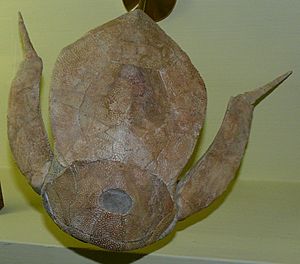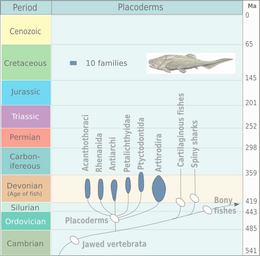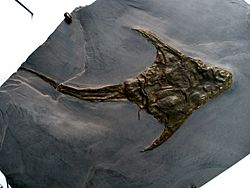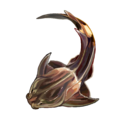Placodermi facts for kids
Quick facts for kids Placoderms |
|
|---|---|
 |
|
| Fossil of Bothriolepis panderi showing its caliper-like pectoral fins | |
| Scientific classification | |
| Kingdom: | |
| Phylum: | |
| Subphylum: | |
| Infraphylum: | |
| Class: |
†Placodermi
McCoy, 1848
|
The Placoderms (Placodermi: Greek = plated skin) were a class of armoured prehistoric fish, which lived from the mid Silurian to the end of the Devonian period. Their head and thorax were covered by armoured plates; the rest of the body was scaled or naked, depending on the species. Placoderms were among the first jawed fish, the Gnathostomata. A 380 million year old fossil of one species is the oldest-known example of live birth.
The placoderms were hugely successful in the Devonian period, which is sometimes called the 'Age of Fish'. In the Upper Devonian, a series of extinction events devastated the marine fauna. As the placoderms were predators, this caused a swift decline in their numbers, and the class was entirely extinct by the end of the Devonian.
The main source of placoderm fossils is the Old Red Sandstone continent. This, in the Devonian, was a united North America and western Europe and the continental shelf areas around it. Fossils from these strata in Scotland were collected since the 18th century, and Louis Agassiz wrote the first survey of fossil fish. A century later, Eric Stensiö showed that placoderms were genuine jawed fish.
Remarkable fossils have more recently been found in the Gogo formation of northern Western Australia. This is a former Upper Devonian reef system, where well-preserved fossils of 25 species have been found. The relationship between the placoderm and other jawed fish is still not clear. Most placoderms were benthic predators, near the bottom of the water column. The largest types, such as Dunkleosteus and Gorgonichthys were 6 metre-long top predators in the middle and upper pelagic zones.
Characteristics
The vast majority of placoderms were predators, many of which lived at or near the substrate. Many, primarily the Arthrodira, were active, nektonic predators that dwelled in the middle to upper portions of the water column. The teeth had well defined pulp cavities and were made of both bone and dentine. However, the tooth and jaw development were not as closely integrated as in modern gnathostomes. These teeth were likely homologous to the teeth of other gnathostomes.
One of the largest known arthrodires, Dunkleosteus terrelli , was 6 m (20 ft) long, and is presumed to have had a large distribution, as its remains have been found in Europe, North America and possibly Morocco.
Evolution and extinction


It was thought for a time that placoderms became extinct due to competition from the first bony fish and early sharks, given a combination of the supposed inherent superiority of bony fish and the presumed sluggishness of placoderms. With more accurate summaries of prehistoric organisms, it is now thought that they systematically died out as marine and freshwater ecologies suffered from the environmental catastrophes of the Devonian/Carboniferous extinction events.
Taxonomy and phylogeny
Currently, Placodermi are divided into eight recognized orders. There are two further controversial orders: One is the monotypic Stensioellida, containing the enigmatic Stensioella; the other is the equally enigmatic Pseudopetalichthyida. These orders are considered to be basal or primitive groups within Placodermi, though their precise placement within the class remains unsure. Fossils of both are currently known only from the Hunsruck lagerstatten.
| Placoderm orders | ||
|---|---|---|
| Arthrodira | 
|
Arthrodira ("jointed neck") were the most diverse and numerically successful of the placoderm orders, occupying roles from giant apex predators to detritus-nibbling bottom dwellers. They had a movable joint between armour surrounding the head and body. As the lower jaw moved down, the head shield moved, allowing for a larger opening. All arthrodires, save for Compagopiscis, lacked teeth, and used instead the sharpened edges of a bony plate, termed a "tooth plate," as a biting surface (Compagopiscis had true teeth in addition to tooth plates). The eye sockets are protected by a bony ring, a feature shared by birds and some ichthyosaurs. Early arthrodires, such as the genus Arctolepis, were well-armoured fishes with flattened bodies. The largest member of this group, Dunkleosteus, was a true "superpredator" of the latest Devonian period, reaching 3 to as much as 9 metres in length. In contrast, the long-nosed Rolfosteus measured just 15 cm. Fossils of Incisoscutum have been found containing unborn fetuses, indicating that arthrodires gave birth to live young. |
| Antiarchi | 
|
Antiarchi ("opposite anus") were the second most successful order of placoderms known, after the Arthrodira. The order's name was coined by Edward Drinker Cope, who, after incorrectly identifying the first fossils as being those of an armored tunicate, mistakenly thought the eye-hole was the mouth, and the opening for the anal siphon was on the other side of the body, as opposed to having both oral and anal siphons together at one end. The front portions of their bodies were heavily armoured, to the point of literally resembling a box with eyes, with the sometimes scaled, sometimes naked rear portions often becoming sinuous, particularly with later forms. The pair of pectoral fins were modified into a pair of caliper-like, or arthropod-like limbs. In primitive forms, such as Yunnanolepis, the limbs were thick and short, while in advanced forms, such as Bothriolepis, the limbs were long and had elbow-like joints. The function of the limbs is still not perfectly understood, but most hypothesize that they helped their owners pull themselves across the substrate, as well as allowing their owners to bury themselves into the substrate. |
| Brindabellaspida |
|
Brindabellaspida ("Brindabella's shield") was a long-snouted placoderm from the Early Devonian. When it was first discovered in 1980, it was originally regarded as a weejasperaspid acanthothoracid due to anatomical similarities with the other species found at the same locality. According to Philippe Janvier, anatomical similarities in the brain of Brindabellaspis stensioi and the brain of a jawless fish suggest it is a basal placoderm closest to the ancestral placoderm. Various Early to Middle Devonian placoderm incertae sedis have also been inserted in the order. |
| Phyllolepida |
|
Phyllolepida ("leaf scales") were flattened placoderms found throughout the world. Like other flattened placoderms they were bottom-dwelling predators that ambushed prey. Unlike other flattened placoderms, they were freshwater fish. Their armour was made of whole plates, rather than the numerous tubercles and scales of Petalichthyida. The eyes were on the sides of the head, unlike visual bottom-dwelling predators, such as stargazers or flatfish, which have eyes on the top of their head. The orbits for the eyes were extremely small, suggesting the eyes were vestigial and that the phyllolepids may have been blind. |
| Ptyctodontida | 
|
Ptyctodontida ("folded teeth") were lightly armoured placoderms with big heads, big eyes and long bodies. They have a strong but superficial resemblance to modern day chimaeras. Their armour was reduced to a pattern of small plates around the head and neck. Like the extinct and related acanthothoracids, and the living and unrelated holocephalians, most of the ptyctodontids are thought to have lived near the sea bottom and preyed on shellfish. On account of their lack of armour, some paleontologists have suggested that the Ptyctodontida were not placoderms, but holocephalians or the ancestors of holocephalians. Anatomical examinations of whole fossil specimens have shown that the similarities between these two groups are superficial. The major differences were that holocephalians have shagreen on their skin, while ptyctodontids do not; the armoured plates and scales of holocephalians are made of dentine, while those of ptyctodontids are made of bone; the craniums of holocephalians are similar to sharks, while those of ptyctodontids are similar to those of other placoderms; and, most importantly, that holocephalians have true teeth, while ptyctodonts have beak-like tooth plates. Ptyctodontids were sexually dimorphic, with the males having pelvic claspers and possibly claspers on the head as well. |
| Rhenanida |
|
Rhenanida ("Rhine fish") were flattened, ray-like, bottom-dwelling predators with large, upturned mouths that lived in marine environments. The rhenanids were once presumed to be the most primitive, or at least the closest to the ancestral placoderm, as their armour was made of unfused components—a mosaic of tubercles—as opposed to the solidified plates of "advanced" placoderms, such as antiarchs and arthrodires. However, through comparisons of skull anatomies, rhenanids are now considered to be the sister group of the antiarchs. When rhenanids die, their "mosaics" come apart, and it has been suggested that the rarity of rhenanids in the fossil record reflects postmortem disassociation, and is not an actual rarity of the species. |
| Acanthothoraci |
|
Acanthothoraci ("spine chests") were a group of chimaera-like placoderms closely related to the rhenanid placoderms. Superficially, acanthoracids resembled scaly chimaeras or small, scaly arthrodires with blunt rostrums. They were distinguished from chimaeras by a pair of large spines that emanate from their chests, the presence of large scales and plates, tooth-like beak plates, and the typical bone-enhanced placoderm eyeball. They were distinguished from other placoderms due to differences in the anatomy of their skulls, and due to patterns on the skull plates and thoracic plates that are unique to this order. From what can be inferred from the mouthplates of fossil specimens, acanthothoracids were shellfish hunters ecologically similar to modern-day chimaeras. Competition with their relatives, the ptyctodont placoderms, may have been one of the main reasons for the acanthothoracids' extinction prior to the mid-Devonian extinction event. |
| Petalichthyida |
|
Petalichthyida ("thin-plated fish") were small, flattened placoderms, typified by their splayed fins and numerous tubercles that decorated all of the plates and scales of their armour. They reached a peak in diversity during the Early Devonian and were found throughout the world. The petalichthids Lunaspis and Wijdeaspis are among the best known. There was an independent diversification event that occurred in what is now Southern China, producing a handful of unique genera that were once placed in their own order, "Quasipetalichthyida", named after the first discovered species there, Quasipetalichthys haikouensis. Soon after the petalichthids' diversification, they went into decline. Because they had compressed body forms, it is supposed they were bottom-dwellers that pursued or ambushed smaller fish. Their diet is not clear, as none of the fossil specimens found have preserved mouth parts. |
| Pseudo- petalichthyida ? |
|
Pseudopetalichthyida ("false petalichthyids") is a group of elongated, possibly flattened fishes comprising three, poorly preserved and poorly studied genera. It is known only from rare fossils in Lower Devonian strata in Hunsrück, Germany. Like Stensioella heintzi, and the Rhenanida, the pseudopetalichthids had armour made up of a mosaic of tubercles. Like Stensioella heintzi, the pseudopetalichthids' placement within Placodermi is suspect. The matter is not easy to resolve because there are no complete, undamaged and articulated specimens. The anatomical studies done on the crushed specimens that have been found indicate that if they are placoderms, they may be a group more advanced than the ptyctodonts. As such, placoderm experts consider Pseudopetalichthyida to be the sister group of the Arthrodires + Phyllolepida + Antiarchi trichotomy and the Acanthothoraci + Rhenanida dichotomy. |
| Stensioellida ? |
|
Stensioellida ("[Heintz's] little Stensio") contains another problematic placoderm of uncertain affinity, known only from the Lower Devonian Hunsrück slates of Germany. Stensioella was a thin fish that, when alive, looked vaguely like an elongated ratfish, or a skinny Gemuendina with thin, strap-like pectoral fins. Similar to those of the Rhenanida, its armour was a complex mosaic of small, scale-like tubercles. The shoulder joints of its armour are similar to other placoderms, and there are superficial similarities in skull plates, and even more superficial similarities between its tubercles and the tubercles of the rhenanids. It is tentatively placed within Placodermi as a primitive placoderm, though some paleontologists believe the rationale for the placement is inadequate. The paleontologist Philippe Janvier has suggested that Stensioella is not a placoderm, but instead is a holocephalian. If this is true, then the holocephalians diverged from sharks before the Chondrichthyan Devonian radiation. Critics of Janvier's position say that aside from a bodyplan superficially similar to primitive holocephalians, the two groups have little else in common anatomically. |
Images for kids
See also
 In Spanish: Placodermi para niños
In Spanish: Placodermi para niños

























